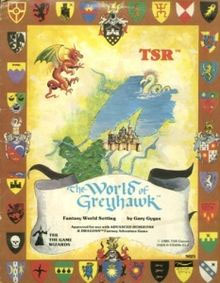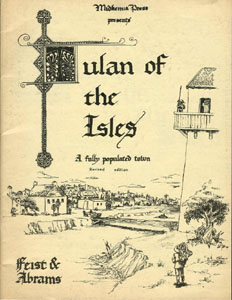Once an experienced GM has learned how to use a particular game structure, it’s usually trivial for them to “bling it out” with additional game structures that add flavor, complexity, or detail to a scenario.
If we take the basic structure of a hexcrawl, for example, what could we add (or tweak) to change (and hopefully improve) our game?
Random Encounters: A simple example. Just as random encounters add life and activity to a dungeon complex, they can also make a wilderness setting come alive. And it’s pretty easy to add periodic encounter checks to our hexcrawl procedures. Of course there are still questions to be answered about our exact methodology: Do we check once per hex? Once per day? Several times per day?
 Hexes Are Big: Does it make sense for PCs to automatically find a hex’s keyed encounter as soon as they enter the hex? Probably not. A typical 30-mile hex (like those used in the original Darlene map of Greyhawk) is larger than New York City and two-thirds the size of Rhode Island. That’s a lot of territory for a couple dozen orcs or a lonely cave entrance to get lost in.
Hexes Are Big: Does it make sense for PCs to automatically find a hex’s keyed encounter as soon as they enter the hex? Probably not. A typical 30-mile hex (like those used in the original Darlene map of Greyhawk) is larger than New York City and two-thirds the size of Rhode Island. That’s a lot of territory for a couple dozen orcs or a lonely cave entrance to get lost in.
To model this, we could make the chance of experiencing a hex’s keyed encounter variable. We could even vary the probability of this (making it less likely to encounter hidden locations and more likely to encounter highly visible locations).
Navigating the Wilderness: Once you’ve left roads and well-beaten trails behind you, it’s relatively easy to become lost in the wilderness (particularly if you’re not properly trained). So rather than just letting players determine precisely the direction they want to go, we could add a skill check to determine whether or not they become lost (and, if they do, determine their true direction of travel randomly). To spice things up, we could set the difficulty of this check based on the terrain type they’re currently traveling through. We could even have weather conditions modify this check (so that, for example, it would be more difficult to find your way on stormy, overcast nights than when the stars were visible).
Mode of Travel: Are the PCs traveling at a normal pace, racing at high speeds, covering their tracks, spending time foraging, or crisscrossing their own path in order to thoroughly explore the local area? Based on these decisions, we could vary the speed at which they travel; the difficulty of navigation; the odds of finding local points of interest; and so forth.
 Other Game Structures: Tulan of the Isles, a lesser known product written by Raymond E. Feist and Stephen Abrams in 1981, includes a full game structure for prospecting gems. The Ready Ref Sheets from Judges Guild included a similar system for prospecting, detailing the amount of time it takes to prospect a hex, the percentile chances of finding a vein of precious metal, and a methodology for randomly determining the type of vein and its value.
Other Game Structures: Tulan of the Isles, a lesser known product written by Raymond E. Feist and Stephen Abrams in 1981, includes a full game structure for prospecting gems. The Ready Ref Sheets from Judges Guild included a similar system for prospecting, detailing the amount of time it takes to prospect a hex, the percentile chances of finding a vein of precious metal, and a methodology for randomly determining the type of vein and its value.
I offer this up not as something that every hexcrawl campaign requires, but rather as an example of how we often don’t think about the game structures that we use. If your players decided they wanted to go prospecting, how would you adjudicate that at the table? Would the method you use remain balanced over time if the players decided to make prospecting a major part of their characters? Could you make it as much as fun as dungeoncrawling? (If not, why not? Think about it.)
Consider, too, how the availability of game structures subconsciously shapes the way we play the game. Would you, as a GM, be more likely to design a scenario hook in which the PCs are hired by a dwarven king to prospect potential gold mines in the Frostbite Peaks if you had a fun little mechanic for prospecting to build a larger situation involving goblin reavers, icingdeath undead, and rogue frostmancers around? Would your cash-strapped players be more likely to spontaneously consider prospecting in the wilderness a viable alternative for cash if the rulebook included a chapter of rules for it?













[…] С оригиналом статьи Вы можете ознакомиться здесь. […]
Hi Justin,
I am preparing a seafaring “sandbox” (based on the old Al Qadim – Golden Voyages TSR supplement) and I wondered if you had some specific article regarding sea travel (or can point to anything that would be helpful besides treating it as a Hexcrawl).
@PaMar Take a look at hex flowers for generating events: https://www.drivethrurpg.com/product/274573/In-the-Heart-of-the-Sea–A-Procedural-High-Seas-Hex-Crawl
I attempted a seacrawl about 10 years ago and it crashed and burned. I was trying to use a hexcrawl structure and it did not work well. (The ocean is big and the density of keyed content to the hexes is too thin, making navigation tedious.)
Very interested to check out the hex flowers Jason links to.
When I can find time to circle back around to this concept, I’m pretty sure I’ll be modeling it as a combination coast-crawl and island-crawl. Probably using some form of point-crawl system; see point-crawls and also Ultraviolet Grasslands for good approaches. I particularly like how UVG fractally generates content around established hubs.
The flip-side of the coin is also figuring out what you want the ship management to be.
In my current roleplay group, they characters are exploring the Caribbean, and to track their ship’s position, I am using an unkeyed hex map, with hexes 60 nautical miles wide (to the best of my ability of researching ship speeds, this is about the distance a ship can cover in 24 hours of sailing with average wind).
It’s a rather rudimentary structure though, not actually meant for player engagement. There’s no rolls involved, players just pick a direction and I do the math. One of the reasons why is that the captain and crew are NPCs, and the players brought along an astronomer NPC, so I just decide that navigation basically happens in a permanent Take 10 state.
I’ve keyed the islands (sort of. Since the group is on an anthropological mission, they “Key” amounts to writing down what pre-columbian people lived on that island. The rest is improvised) and noted in my map the position and direction of major sea currents. Those currents, together with the weather system defining wind, serve as sources for uncertainty in place of Seafaring and Navigation rolls.
@Jason – I own the hex-based product (In the Heart of the Sea – A Procedural High Seas ‘Hex Crawl’) and I plan to make use of it.
The PCs will act as nakhudas (i.e. – according to the TSR module “The nakhuda has final say on when the ship sails, where it sails to, and what cargoes it will pick up including any passengers.”) i.e. they will be sent by higher powers to “manage” the expedition but noone of them has an actual technical role (i.e. navigator, captain, etc.)
The whole sandbox module is supposed to run as follows: give an important artifact to retrieve somewhere in a large archipelago, starting from location X and then dynamically generate the next destination based on clues and actions by the the party.
My plan is to pre-calculate the average duration of each leg (e.g. from the departing port to X it will be 10 days), and roll every day for minor and major events (I have plenty of supplements for that) and use the procedural hex-engine to find out if they are delayed, get lost etc. (in total they will have 90 days to find the artifact and come back).
It could very well become boring, but then I can just fast forward the open sea parts and concentrate on the many mini-adventures on the various islands.